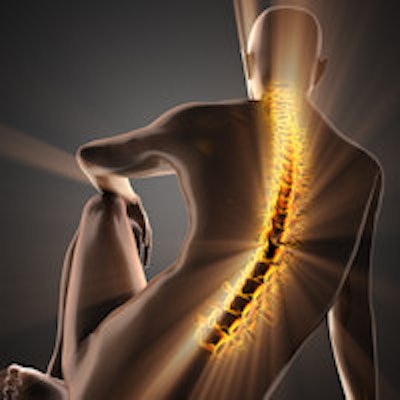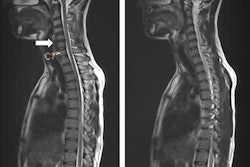
Researchers from Belgium have identified an optimal protocol for whole-spine radiography using antiscatter grids and filtration. The protocol cut radiation dose by around 70% for posteroanterior (PA) view and 30% for lateral (LA) view radiographs.
Full-spine radiography remains the gold standard for identifying and monitoring scoliosis, defined as lateral curvature of the spine, according to lead author Dr. Caroline Ernst, from the department of radiology at Universitair Ziekenhuis Brussel (UZ Brussel) in Brussels. The condition occurs in between 2% and 4% of children 6 to 14 years of age, and imaging is required to help determine treatment by characterizing the type of curve and its severity, identify possible underlying pathologies, and detect any increase in deformation.
"Scoliosis patients typically receive multiple radiographs during treatment and follow-up," the authors noted in an e-poster presentation at ECR 2016 in Vienna. "Average numbers of 22.9 radiographs per patient are reported in the literature. Owing to the increased radiation sensitivity of children and the numerous follow-up images with exposure of the most sensitive organs (thyroid gland, mammary gland, and gonads), radiation safety is of particular concern in patients with scoliosis."
Ernst and her two colleagues from UZ Brussel -- Nico Buls, PhD, from the department of radiology, and Dr. Armand Laumen, from the department of orthopedics -- conducted a phantom study to optimize the standard full-spine radiography protocol with respect to diagnostic quality and radiation dose. They used an adult humanoid Rando Alderson phantom (Phantom Laboratory, Greenwich, New York). These phantoms are molded of tissue-equivalent material and are designed within highly sophisticated technological constraints. The phantom is transected horizontally into 2.5-cm-thick slices. To include the effect of a brace, a specific device was manufactured to match the phantom size.
The team performed all examinations on a full digital x-ray device (Axiom Luminos dRF, Siemens Healthcare). The technical parameters of the standard full-spine protocol for both in-brace and without brace imaging were 85 kVp (PA view) or 113 kVp (LA view), and relative dose per pulse was 1.39 (range 0.5-2.6). Automated exposure control and an antiscatter grid were used, with no additional spectral filter.
This standard protocol resulted in a dose-area product (DAP) of 149.7 µGym2 and 187.7 µGym2 for PA and LA views, respectively, Ernst and colleagues noted.
The researchers assessed the impact of these parameters: tube potential (kVp), relative dose per pulse, and additional filtration and antiscatter grid. The relative dose per pulse parameter was altered in technical service mode with the support of the manufacturer. A total of 50 different protocols were investigated: 21 PA views without a brace and 13 in-brace, plus eight LA views each for without brace and in-brace.
A pediatric radiologist and a pediatric orthopedic specialist evaluated the diagnostic quality for the following criteria in PA view: bone sharpness, contrast between soft tissue and bone, spine curvature, confidence of Risser grade, visibility of pedicles, and processi spinosi. For the LA view, the researchers assessed bone sharpness, contrast between soft tissue and bone, and spine curvature. They graded each criterium on a five-point scale, ranging from 0 to high diagnostic confidence. The optimal protocol was defined as having the lowest dose with noninferior quality compared with the standard protocol.
For the PA and LA view protocols, the DAP varied from 14.3 µGym2 to 176.8 µGym2 and from 53.0 µGym2 to 214.9 µGym2, respectively, the authors reported. The presence of the antiscatter grid increased dose by 132%, and the use of a 0.3-mm copper filter cut dose by 65%. The use of 102 kVp in PA view increased dose by 42%, and the presence of a brace increased dose by 11%.
"For all criteria in PA view, we did not observe a difference in scores between protocols, with exception of the visibility of the processus spinosus during absence of the antiscatter grid," they stated. "When no grid was present, the reported image quality was reduced by one point. The presence or absence of a brace had no influence on image quality."
The lowest dose PA protocol that still yielded noninferior quality was identified as 85 kVp, 0.87 relative dose per pulse, with grid and 0.3-mm copper filter, resulting in a DAP of 44.7 µGym2.
For the LA view, the researchers found no difference in scores between the protocols. Consequently, they selected the protocol with the lowest dose. This was identified as 113 kVp, 1.09 dose per pulse, with grid and 0.3-mm copper filter, resulting in a DAP of 116.8 µGym2.
Little information is available about radiation dosimetry for full-spine radiography in the literature, Ernst added. Yoon et al reported DAP values for 50 adult patients, and compared with Ernst's results, the mean DAP values were very high: 425.7 µGym2 and 1144.9 µGym2 for AP and LA views, respectively. Yvert et al evaluated AP view doses with a flat-panel digital detector and slot-scanning system for 12-year-old children and reported comparable values with the dose of Ernst's optimized protocol.
"Considering our adult humanoid patient model, we believe actual pediatric patient doses will probably be lower due their smaller posture," the Belgian group concluded. "Our reported values, therefore, probably represent the upper DAP values for a pediatric patient group. This needs to be further investigated in a clinical study."
To view the full e-poster from ECR 2016, click here.


















